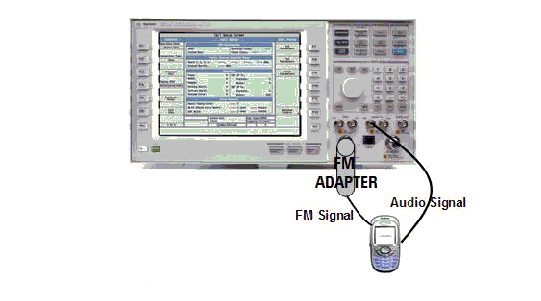FM Broadcast
Last updated: January 15, 2009
Description
You can use the test set coupled with the audio measurement features to test the Mobile Station with full range of FM (frequency modulated) Broadcast signals. The FM Broadcast signals are generated by utilizing two RF sources in the test set and an external mixing device (E5520 FM Adaptor).
FM Broadcast test system
The following diagram shows a typical FM Broadcast test system configuration.

The FM Broadcast test system is made up of the test set, FM Adapter and Mobile Station. The FM Adapter connects to the RF OUT ONLY port of the test set directly. The Mobile Station connects to the output of the FM Adapter with RF antenna. To make measurement on the received audio signal, the Mobile Station's demodulated FM output connects to the High AUDIO IN connector of the test set.
When the test set is in CW operating mode and FM broadcast mode, one of the test set's RF sources is fixed at 1 GHz and the other source provides an FM signal from 890 MHz to 990 MHz. The FM Adapter mixes the 1 GHz Local Oscillator signal with the FM signal, then the filters it to provide a stable and accurate resultant signal at the user specified FM broadcast frequency (10 MHz to 110 MHz). The test set also allows you to set parameters such as internal frequency deviation, FM broadcast power and amplitude offset when the test set is in FM Broadcast mode. Once the test set is generating the FM signal and is properly connected to the Mobile Station, the Mobile Station's FM receiver performance is ready to analyzed. A common method of analyzing the FM signal that has been demodulated by the Mobile Station is to connect the Mobile Station's demodulated FM output to the test set's High AUDIO INPUT connector, perform and run the appropriate Audio Analyzer measurements.
FM Broadcast Parameters
RF Output Config
There are two RF generator configuration settings:
- Normal: This mode is the normal CW operating mode in which the test set generates a CW signal.
- FM broadcast: In this mode, the test set generates the signals that are sent through the RF OUT ONLY port to the FM Adapter to produce an FM Broadcast signal. The FM Broadcast parameters do not appear on the front panel of the test set and the GPIB command that set the FM Broadcast parameters do not apply until the RF Output Configure parameter is set to this mode.
This parameter only applies when RF Output Configure is set to FM Broadcast.
The GPIB command to set this parameter is CALL[:CELL]:RFGenerator:CONFigure .
FM Broadcast Frequency
This parameter sets the frequency at which the test set broadcasts the FM signal.
This parameter only applies when RF Output Configure is set to FM Broadcast.
The GPIB command to set this parameter is CALL[:CELL]:RFGenerator:FMBRoadcast:FREQuency .
FM Broadcast Power
-
FM Broadcast Power State
This parameter sets whether the FM Broadcast Power setting is applied.
This parameter only applies when RF Output Configure is set to FM Broadcast.
The GPIB command to set this parameter is CALL[:CELL]:RFGenerator:FMBRoadcast:POWer:STATe .
-
FM Broadcast Power
This parameter sets the power at which the test set broadcasts the FM signal.
This parameter only applies when RF Output Configure is set to FM Broadcast.
The GPIB command to set this parameter is CALL[:CELL]:RFGenerator:FMBRoadcast:POWer:AMPLitude .
FM Broadcast Amplitude Offset menu
-
Adapter Conversion Gain
This parameter sets the loss of the FM Adapter. The test set compensates for the loss by increasing the signal strength at the RF OUT ONLY port.
This parameter only applies when RF Output Configure is set to FM Broadcast.
The GPIB command to set this parameter is CALL[:CELL]:RFGenerator:FMBRoadcast:ADAPter:GAIN .
-
Amplitude Offset State
This parameter sets whether the FM Broadcast mode Amplitude Offset setting is applied.
This parameter only applies when RF Output Configure is set to FM Broadcast.
The GPIB command to set this parameter is CALL[:CELL]:RFGenerator:FMBRoadcast:CORRection:STATe .
-
Amplitude Offset
This parameter sets the FM Broadcast mode Amplitude Offset setting that is applied to the RF OUT ONLY port.
This parameter only applies when RF Output Configure is set to FM Broadcast.
The GPIB command to set this parameter is CALL[:CELL]:RFGenerator:FMBRoadcast:CORRection:GAIN .
Internal FM Deviation
-
Internal FM Deviation State
This parameter sets whether the FM Broadcast mode Internal FM Deviation setting is applied.
This parameter only applies when RF Output Configure is set to FM Broadcast.
The GPIB command to set this parameter is CALL[:CELL]:RFGenerator:FMBRoadcast:FM:INTernal:STATe .
-
Internal FM Deviation
This parameter is used to control the FM Deviation of the internal audio source. The internal audio source is the amount the modulated signal deviates from the carrier frequency.
This parameter only applies when RF Output Configure is set to FM Broadcast.
The GPIB command to set this parameter is CALL[:CELL]:RFGenerator:FMBRoadcast:FM:INTernal:DEViation .
Internal FM Frequency
This parameter sets the test set's internal FM frequency. (This is simply the modulation frequency.)
This parameter only applies when RF Output Configure is set to FM Broadcast.
The GPIB command to set this parameter is CALL[:CELL]:RFGenerator:FMBRoadcast:FM:INTernal:FREQuency .